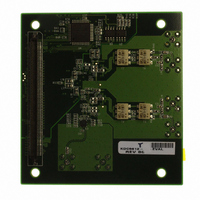KDC5612EVAL Intersil, KDC5612EVAL Datasheet - Page 27

KDC5612EVAL
Manufacturer Part Number
KDC5612EVAL
Description
DAUGHTER CARD FOR KAD5612
Manufacturer
Intersil
Series
FemtoCharge™r
Datasheets
1.KAD5612P-25Q72.pdf
(29 pages)
2.KMB-001LEVALZ.pdf
(7 pages)
3.KDC5514EVALZ.pdf
(9 pages)
Specifications of KDC5612EVAL
Number Of Adc's
2
Number Of Bits
12
Sampling Rate (per Second)
250M
Data Interface
Parallel
Inputs Per Adc
1 Differential
Input Range
1.47 Vpp
Power (typ) @ Conditions
429mW @ 250MSPS
Voltage Supply Source
Single Supply
Operating Temperature
-40°C ~ 85°C
Utilized Ic / Part
KAD5612P-25, KMB001 Motherboard
For Use With
KMB001LEVAL - MOTHERBOARD FOR LVDS ADC CARD
Lead Free Status / RoHS Status
Lead free / RoHS Compliant
LVDS Outputs
Output traces and connections must be designed for 50Ω
(100Ω differential) characteristic impedance. Keep traces
direct and minimize bends where possible. Avoid crossing
ground and power-plane breaks with signal traces.
LVCMOS Outputs
Output traces and connections must be designed for 50Ω
characteristic impedance.
Unused Inputs
Standard logic inputs (RESETN, CSB, SCLK, SDIO, SDO)
which will not be operated do not require connection to
ensure optimal ADC performance. These inputs can be left
floating if they are not used. Tri-level inputs (NAPSLP,
OUTMODE, OUTFMT, CLKDIV) accept a floating input as a
valid state, and therefore should be biased according to the
desired functionality.
Definitions
Analog Input Bandwidth is the analog input frequency at
which the spectral output power at the fundamental
frequency (as determined by FFT analysis) is reduced by
3dB from its full-scale low-frequency value. This is also
referred to as Full Power Bandwidth.
Aperture Delay or Sampling Delay is the time required
after the rise of the clock input for the sampling switch to
open, at which time the signal is held for conversion.
Aperture Jitter is the RMS variation in aperture delay for a
set of samples.
Clock Duty Cycle is the ratio of the time the clock wave is at
logic high to the total time of one clock period.
Differential Non-Linearity (DNL) is the deviation of any
code width from an ideal 1 LSB step.
Effective Number of Bits (ENOB) is an alternate method of
specifying Signal to Noise-and-Distortion Ratio (SINAD). In
dB, it is calculated as: ENOB = (SINAD - 1.76)/6.02
Gain Error is the ratio of the difference between the voltages
that cause the lowest and highest code transitions to the
full-scale voltage less 2 LSB. It is typically expressed in
percent.
Integral Non-Linearity (INL) is the maximum deviation of
the ADC’s transfer function from a best fit line determined by
a least squares curve fit of that transfer function, measured
in units of LSBs.
Least Significant Bit (LSB) is the bit that has the smallest
value or weight in a digital word. Its value in terms of input
voltage is V
FS
/(2
N
- 1) where N is the resolution in bits.
27
KAD5612P
Missing Codes are output codes that are skipped and will
never appear at the ADC output. These codes cannot be
reached with any input value.
Most Significant Bit (MSB) is the bit that has the largest
value or weight.
Pipeline Delay is the number of clock cycles between the
initiation of a conversion and the appearance at the output
pins of the data.
Power Supply Rejection Ratio (PSRR) is the ratio of the
observed magnitude of a spur in the ADC FFT, caused by an
AC signal superimposed on the power supply voltage.
Signal to Noise-and-Distortion (SINAD) is the ratio of the
RMS signal amplitude to the RMS sum of all other spectral
components below one half the clock frequency, including
harmonics but excluding DC.
Signal-to-Noise Ratio (without Harmonics) is the ratio of
the RMS signal amplitude to the RMS sum of all other
spectral components below one-half the sampling frequency,
excluding harmonics and DC.
SNR and SINAD are either given in units of dB when the
power of the fundamental is used as the reference, or dBFS
(dB to full scale) when the converter’s full-scale input power
is used as the reference.
Spurious-Free-Dynamic Range (SFDR) is the ratio of the
RMS signal amplitude to the RMS value of the largest
spurious spectral component. The largest spurious spectral
component may or may not be a harmonic.
Two-Tone SFDR is the ratio of the RMS value of the lowest
power input tone to the RMS value of the peak spurious
component, which may or may not be an IMD product.
September 9, 2009
FN6803.2










